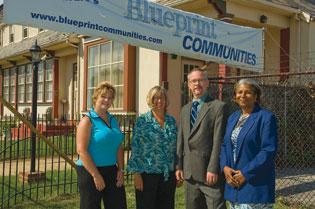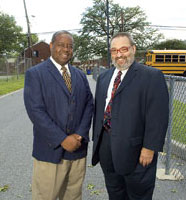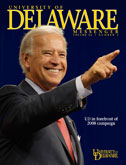Neighborhoods create blueprints for change

ON THE GREEN | Will Robinson has a vision for the northeast Wilmington, Del., neighborhood that surrounds the charter school where he is principal. Instead of decaying public-housing units and residents who feel overwhelmed by the neighborhood’s poverty and crime, he foresees a community of new homes, revitalized businesses and lives that have been transformed by hope and opportunity.
A few miles north of Robinson’s Eastlake neighborhood is another community and another vision for a brighter future. In the Overlook Colony section of Claymont, Del., Dawn Lamb is planning for a similar renewal that will take advantage of the solid housing stock and sense of community that make up this historic neighborhood.
In both of these communities—as well as seven others in Delaware—residents are doing
more than hoping for transformation. Their neighborhoods have been designated as Blueprint Communities in a program established to educate and involve residents in making and implementing specific plans for revitalization.

Sponsored by the Federal Home Loan Bank of Pittsburgh and UD’s Center for Community Research and Service (CCRS), the initiative was announced earlier this year at a news conference at the University. Since then, each neighborhood has set up a planning team that includes a government representative, a banker, community leaders and residents and has taken part in several training and coaching sessions led by the CCRS, which also provides other technical assistance in the planning process.
“We want to get a model for revitalization that’s going to work from the ground up, and to do that, we need residents to get in front of this—to be involved before we start demolishing and rebuilding so they can be part of it when it’s completed,” Robinson says. “I think the Blueprint program and the training and coaching sessions are a fantastic way to help us accomplish this.”
Blueprint Communities provides each team with community development training valued at about $25,000, a mini-grant and improved access to funding sources. The Delaware program follows similar initiatives in Pennsylvania and West Virginia begun in 2005 and 2007 and involving a total of 32 communities.
Delaware’s is the first such program to have a university component, according to Raheemah Jabbar-Bey, assistant professor of urban affairs and public policy and director of the CCRS Community-Based Development Training Program. Training and coaching sessions for the Blueprint teams were held throughout the spring and summer, she says, with the goal of each group completing a redevelopment plan by January.
“This project is an excellent example of the power of partnership, something the University of Delaware believes is essential to the advancement of the state, the region, the nation and the world,” UD President Patrick Harker said when the Blueprint initiative was announced. “UD’s Center for Community Research and Service has a distinguished history of working with organizations and communities to promote social and economic justice, and we are proud to join with the Federal Home Loan Bank of Pittsburgh to sponsor this significant initiative.”
Under the program, the neighborhood planning teams that develop a clear vision for their community’s future and a comprehensive strategic plan will be given access to a network of potential public and private funding sources for coordinated investments, as well as ongoing technical training.
“Wonderful strides in community organization, planning and development have been made in a very short time by many of the teams in Pennsylvania and West Virginia,” says John R. Price, president and CEO of Federal Home Loan Bank. “We expect the same thing to happen once our Delaware teams complete their training.”
The bank is providing about $250,000 to cover expenses associated with Blueprint Communities training, while the Delaware Community Investment Corporation has contributed $100,000 to be used as seed grants by communities once they have completed training.
The bank also has set aside funds in its community investment programs to assist the nine communities in small-business startup and growth and first-time homeownership. Competitive scoring criteria for the bank’s Affordable Housing Program also have been aligned to support projects from communities that have holistic development plans, which should aid Blueprint Communities seeking grant money for affordable housing construction and rehabilitation, the bank says.
In Claymont, a larger redevelopment effort is under way, but Overlook Colony—a neighborhood originally built as a “workers’ village” to house employees of nearby General Chemical Co. and their families—was not part of the initial plan. Being designated a Blueprint Community has been especially helpful in enabling Overlook Colony to be part of the broader renewal, says Brett Saddler, executive director of the Claymont Renaissance Development Corp. and leader of the Blueprint team.
“We’ve made use of the civic association meetings to involve residents in this effort,” Saddler says. “We understand the importance of engaging the community, because the redevelopment won’t work without them.”
Cathy Imburgia, an auxiliary member of the team whose communications business has its office in Overlook Colony, praises the training and support from UD in such areas as grant writing and fundraising, as well as in fostering public involvement. “I’m impressed that the University has made such an investment in helping a community get involved in economic development,” she says.
Delaware’s Blueprint Communities, which were chosen based on their current capacity to plan and implement community revitalization initiatives and assemble diverse and broad-based teams to develop detailed strategic plans, are: Belvedere/Cedar Heights vicinity, Edgemoor and Overlook Colony vicinity, all near Wilmington; Dover Community Partnership; East Side, Hilltop/Little Italy, Riverside Initiative and Second District, all in Wilmington; and Rose Hill, near New Castle.
In addition to Jabbar-Bey, the planning groups’ coaches are Steven Peuquet, associate professor of urban affairs and public policy and CCRS director; Bahira Sherif Trask, professor of human development and family studies and an associate policy scientist with the center; and doctoral student Cara Robinson. Financial institutions that have representatives on the nine Blueprint Communities teams include Citicorp, Trust Bank, JPMorganChase, PNC Bank, Wilmington Savings Fund Society and Wilmington Trust.
For more information, visit www.BlueprintCommunities.com.
Article by Ann Manser, AS ’73





